The ASRock Z370 Gaming-ITX/ac Motherboard Review: Mini-ITX with Thunderbolt 3
by Joe Shields on July 13, 2018 9:00 AM EST- Posted in
- Motherboards
- Gaming
- Intel
- ASRock
- Mini ITX
- 802.11ac
- Wi-Fi
- Coffee Lake
- Z370
- i7-8700K
Visual Inspection
With mini-ITX motherboards, there isn't a lot of room for aesthetics, so they tend to have a fairly basic black PCB. ASRock uses two heatsinks connected via heat pipes to cool part of the power delivery area as well as the PCH. The heatsinks are grey colored and have grooves running through them for the increased area as well as for the appearance. Outside of that, we are able to see the two DRAM slots, as well as the single PCIe slot which is reinforced to help with heavy video cards. The board includes six SATA ports all oriented vertically on the front while the single M.2 slot hides out on the rear.
A total of three RGB LEDs line the back of the board under the PCIe slot which gives illuminates the board when on. An additional RGB LED header is located just above the 24-pin ATX connector and supports up to 12V/3A (36W) LED strip. Both the integrated LEDs and the attached are controlled by the ASRock RGB LED software.
The ASRock Z370 Gaming ITX/ac has three 4-pin fan headers all located across the top. The chassis fan is located on the left by the Wi-Fi module while the CPU fan and CPU Opt/W Pump headers are to the right. The CPU fan connector supports a maximum of 1A (12W) while the Opt/W Pump header supports up to 1.5A (18W) and also auto-detects if it is a 3-pin or 4-pin device.
The Mini-ITX board uses a 7-phase power delivery area split up into a 5+2 configuration. Controlling the power is an Intersil ISL69138 digital multiphase controller that can be configured to operate up to seven channels. This unit sends power to the Intersil ISL99227 Smart Power Stage Modules supporting up to 60A. Power is fed to these devices by a single 8-pin EPS 12V connector just above the CPU socket. This solution shouldn't have any issues driving the Coffee Lake CPUs.
The right side of the board contains a lot of headers and ports with which to connect a plethora of peripherals. Starting on the bottom we are able to see a USB 2.0 header along with the front panel header just below it. To their right is a front panel USB 3.0 header as well as two (of six) SATA ports. The other four are located on the other side of the two DRAM slots. Of note on the SATA ports, when a SATA based M.2 module is used SATA 0 port will be disabled. The SATA ports support RAID 0, 1, 5, and 10. To their right is the 24-pin ATX connector as well as the single RGB LED header in white.
Audio duties are handled by the latest Realtek ALC1220 codec and use Nichicon audio caps to filter the sound. The board includes a Texas Instruments NE5532 OpAmp which auto-senses impedance and supports up to 600 Ohm headsets. The board separates the left and right channels in different PCB layers as well as other isolation methods to reduce EMI interference.
The single full-length and reinforced PCIe slot runs at x16 speeds and also supports bifurcation and is able to split to an x8/x8 configuration with a riser card.
Here is the Thunderbolt 3 controller, Intel's JHL6240 "Alpine Ridge", which is a low-power PCIe x2-based controller. This comes out to a USB Type-C port on the rear panel, which can also be used as a USB 3.1 port and supports Power Delivery 2.0 up to 36 W (12V at 3A) for fast charging. The port also supports DisplayPort USB-C modes up to full 4K at 60 Hz.
The back panel IO (below) is relatively busy with multiple stacks covering USB, audio, network, and video outputs. A complete list is found below ordered from left to right.
- Clear CMOS button
- Wi-Fi module (802.11ac)
- PS/2 Mouse/Keyboard port
- 2 x USB 3.0
- SPDIF Output
- HDMI 2.0
- DisplayPort (1.2)
- 2 x USB 3.0
- 1 x Thunderbolt 3 (also USB 3.1, DP, PD)
- 2 x USB 3.0
- 6-plug audio stack
In The Box
ASRock Includes the following:
- Quick Installation Guide, Software Setup Guide
- I/O Shield
- Driver Disk
- 2 x SATA cables
- 1 x ASRock Wi-Fi Antenna
- 1 x Screw for M.2 socket
For a gaming motherboard, this is pretty barebones, most likely to keep the price down.


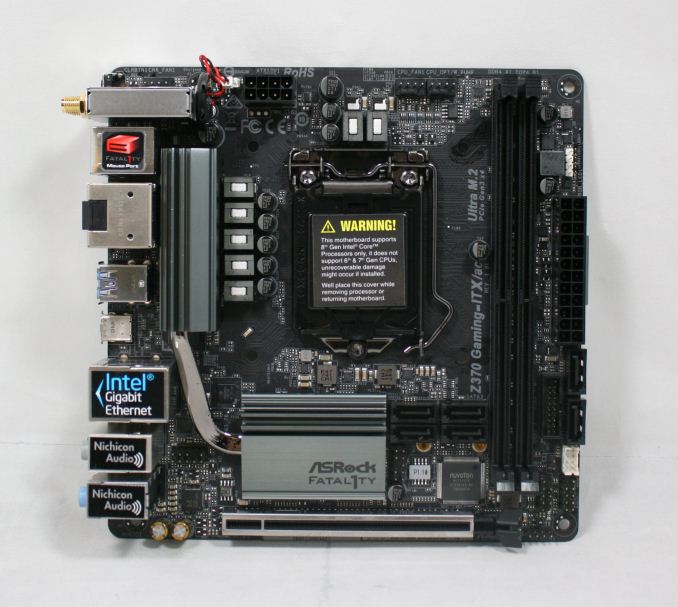
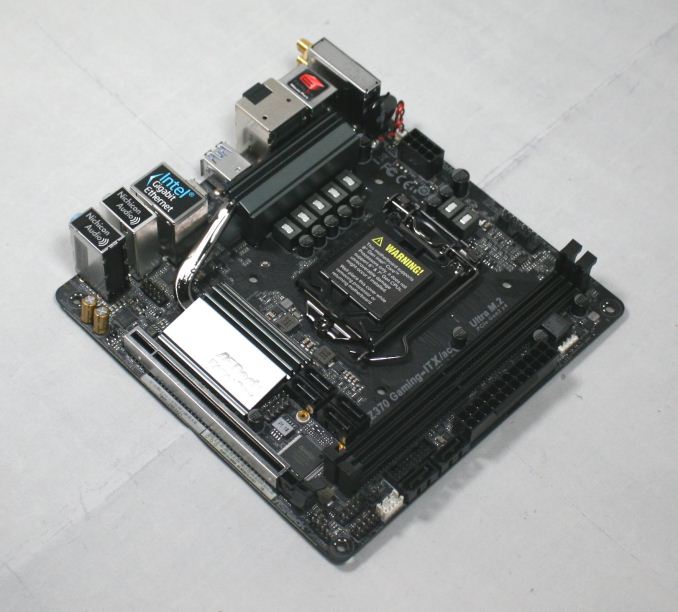
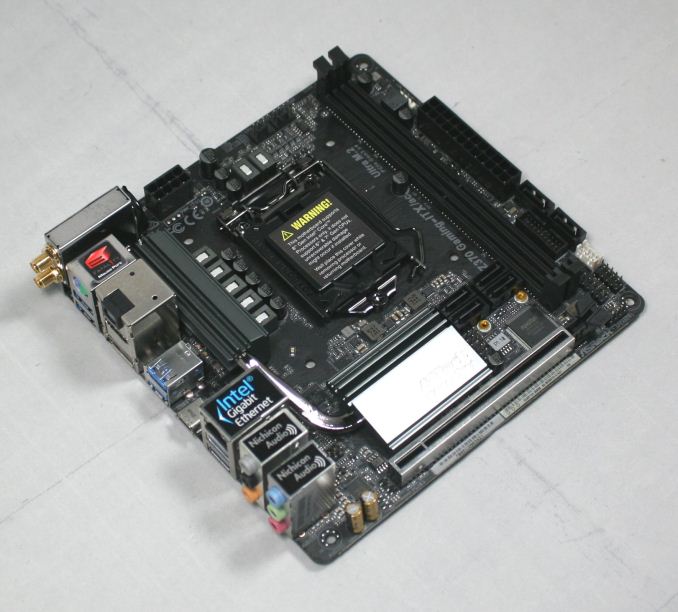

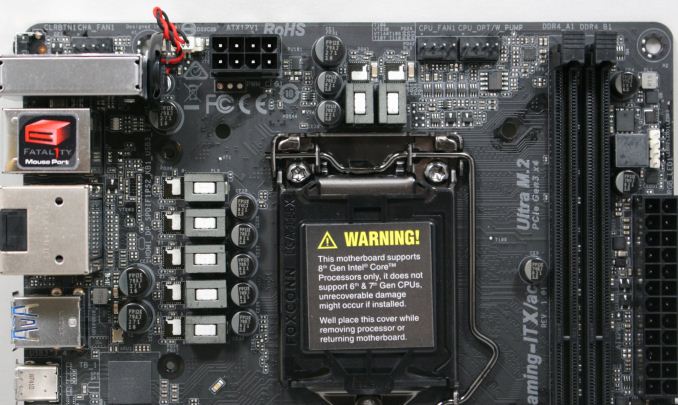
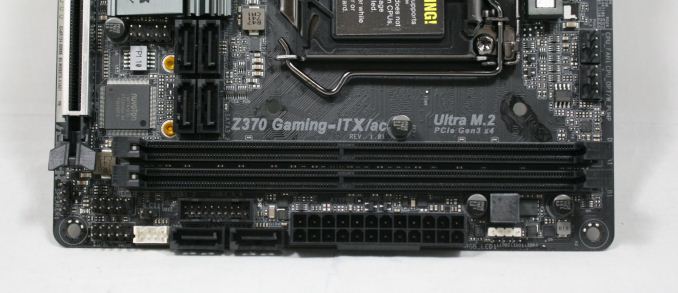



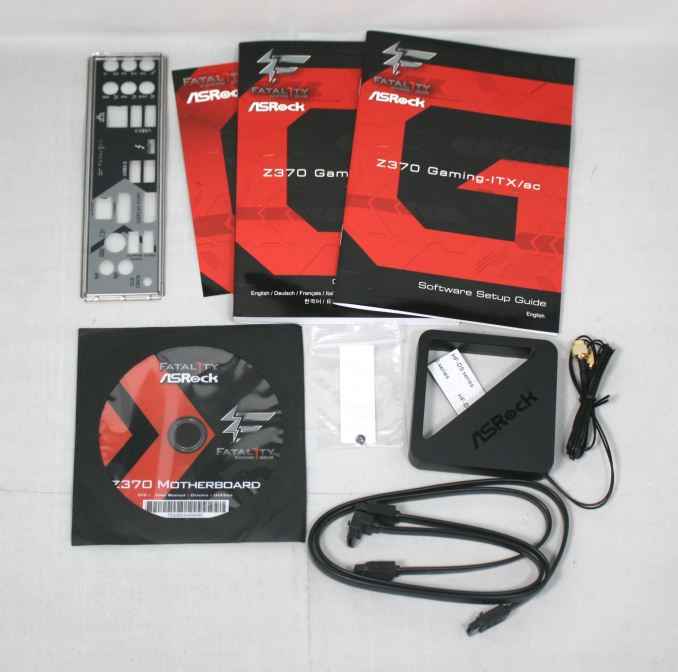














33 Comments
View All Comments
stanleyipkiss - Friday, July 13, 2018 - link
Best buy for any situation right here. Amazing Z370 board.Samus - Saturday, July 14, 2018 - link
Totally upgrading to this from my ASRock H87M-ITX, which has held solid for 4 years with an over locked i5-4670k.The main appeal isn’t just that coffee lake is finally a worthy upgrade from previous generations, especially Haswell, but that platforms simply lacked PCIe m.2 until recently and that’s where the performance gain will be most noticeable. Going from 500MB/sec SSD to 2800MB/sec is huge. And with 12 thread CPU’s to back it up I can’t wait to unrar 8GB 1080p videos in 3 seconds.
n13L5 - Sunday, August 5, 2018 - link
Really? With Cocaine Lake 8-cores and Z390 boards imminent?foxen - Friday, July 13, 2018 - link
minor typo: in the visual inspection when you list the I/O on the back panel, you miss the GigE nic.Gunbuster - Friday, July 13, 2018 - link
Warning to prospective buyers. Today's date is 7/13/2018. Check out the driver and software page for this board. Nearly everything is from 2017.You will not get timely support from ASRock.
ikjadoon - Friday, July 13, 2018 - link
Do you still have this motherboard? I have this board and, for the life of me, I can't figure out what that white 8-pin header does next to two of the SATA ports.https://i.imgur.com/aBTTB07.png (it's missing even in the motherboard manual!)
Thought mine was weird, but even your sample has it--most mysteriously, none of ASRock's other Z370 motherboards have it nor the ASRock Z270 Gaming-ITX/ac!
Isn't space a premium in mini-ITX boards? Why would you leave an extra 8-pin header on such a board? It barely fits anyways between the SATA ports and the front panel I/O header.
ikjadoon - Friday, July 13, 2018 - link
Oh, right: I love this motherboard. Absolutely fantastic: excellent list of full-fat features, runs cool (def. disabled MCE, though), excellent RAM overclocking support, proper 2x2 WiFi, BIOS is complete and full-featured, ASRock updated expeditiously for Spectre/Meltdown (big kudos from me as software support starts to differentiate these commodity products), simple layout, no real gotchas (except the TB3 is only wired as PCIe 2x instead of 4x--but who is honestly driving eGPUs or wild iGPU-heavy docks from a gaming mini-ITX motherboard?!), and the built-in RGB is fun to play with (and syncs nicely with proper lighting).The most minor of cons which some random dude/dudette just has to have, but should be noted for completeness: TB3 is 2x lanes, no USB 3.1 header (though ITX case support is even worse), RGB header is the standard 4-pin and not the fancy RGBW 5-pin, single M.2 slot (but, if you deeply care, you can bifurcate the PCIe x16 and add a $20 PCIe M.2 slot adapter), and the WiFi antenna could be better (a million replacements on Amazon, though, and fine to keep the price down).
esoterikos13 - Friday, July 13, 2018 - link
I have the same board and I have no clue either! LMAOAnandIdiots - Friday, July 13, 2018 - link
No mention of the onboard Thunderbolt 3 controller being the lesser 20Gb/s, single-port version? This a sponsored review or just a place to get shitty, misleading reviews?mkaibear - Friday, July 13, 2018 - link
Doesn't it hang off the DMI3 anyway? So it shares 4xPCIe 3.0 bandwidth with every other I/O on the board except the graphics card?As in, roughly 32Gb/s for everything?
Why would they put a 40Gbs port on it when even in the absolute best case scenario they'd not be able to use it?